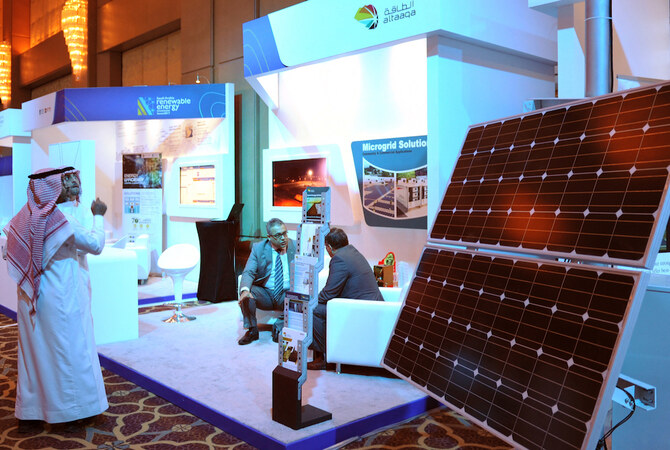Saudi Arabia’s established prowess in crude oil production could help the Kingdom emerge as a global leader in the renewable energy sector, experts suggest.
Paul Sullivan, an energy and environment expert at Johns Hopkins University, emphasized that Saudi Arabia possesses the technical and engineering skills necessary to become a central hub for renewable energy.
Speaking with Arab News, he explained that the Kingdom’s vast experience in energy production could be leveraged to accelerate its transition toward cleaner energy sources.
Bolstering renewable energy capacity is critical for Saudi Arabia as it aims to generate 130 gigawatts of clean energy by 2030 and achieve net-zero emissions by 2060.
At the center of this ambitious plan is NEOM, a flagship project through which Saudi Arabia intends to become a leading manufacturer and exporter of green hydrogen. NEOM, in partnership with ACWA Power and Air Products, aims to export up to 600 tonnes of hydrogen per day by 2026.
“Saudi Arabia has many technical, business, and engineering skills that can spill over from oil and gas to renewables. One obvious one is drilling. Advanced drilling techniques can be used to develop geothermal energy in many places in the Kingdom,” said Sullivan.
He further noted: “Saudi Arabia has massive potential for geothermal energy. Skills in developing pipelines, refineries, ports, pumping stations, and more could also be transferred to geothermal.”
Sullivan also pointed out that expertise in electrical engineering and the construction industry, honed through Saudi Arabia’s legacy oil business, can be used to build new energy systems, including wind, solar, geothermal, and nuclear power.
“Saudi Arabia has a lot of financial clout from its oil business that could be redirected, but properly, to green energy and other environmental industries such as advanced desalination,” he added.
Technical and commercial expertise
Peter Brishimov, a partner in Energy and Process Industries at Kearney Middle East and Africa, echoed similar sentiments, emphasizing that Saudi Arabia’s experience in crude oil production provides a solid foundation for future renewable energy projects.
“In terms of technology, it is leveraging its track record in effectively deploying large-scale capital projects. On the commercialization front, given that the market for renewable energy is not yet as global as the one for oil, the Kingdom is building the bridge to make renewable energy commercially viable in both the short term and long term,” Brishimov explained.
He noted that Saudi Arabia is also focused on expanding its interconnection infrastructure and advancing green hydrogen production, which would enable the Kingdom to meet its own renewable energy needs while positioning itself as a global player.
Sullivan suggested that Saudi Arabia could quickly transform its traditional energy infrastructure into facilities capable of producing green energy.
“All over the world, traditional energy systems are being transformed into green energy hubs. The knowledge is out there. Saudi Arabia can build on that with its excellent energy research institutes, universities, and think tanks. KAPSARC comes to mind,” he said.
In August, a collaboration between KAUST, NEOM’s Education, Research, and Innovation Foundation, and ENOWA was announced to accelerate the development of Saudi Arabia’s hydrogen economy. As part of the agreement, ERIF will sponsor three strategic projects focused on hydrogen research, working in partnership with KAUST researchers to advance the development of hydrogen as a renewable energy source.
Human capital development
Sullivan also emphasized the importance of retraining the Kingdom’s workforce to support the green energy transition.
“The traditional energy workforce will need retraining for the skills that are not transferable. Some people may not move that easily to newer ways of doing things, and some may be left behind. Younger people should be educated in the new opportunities. The training and education systems for traditional energy can be developed alongside the same for the new systems,” he said.
Brishimov highlighted that human capital development is crucial for the energy transition, often overshadowed by factors such as natural resources and capital availability.
“Based on its track record in building an oil industry, the Kingdom is in a strong position to do the same in the renewable energy domain. Through its national policies for enabling human capital development and Saudization requirements, Saudi Arabia is positioning itself to successfully transition its workforce,” he added.
Potential challenges
Discussing potential obstacles, Sullivan pointed out that some critical minerals and metals required for green energy production, particularly in electric vehicles, will need to be imported. However, he noted that Saudi Arabia is making strides in developing its mining sector, which could mitigate this issue in the future.
“The fact that it is so inexpensive to get the oil out of the ground can hamper the development of green energy. Legacy systems that are cash cows can slow down the development of new industries,” Sullivan said.
However, he also noted that, as seen in China’s transition, the development of green energy does not necessarily hinder the growth of new energy sectors.
“The development of green energy as the Chinese used coal to develop their green energy. So, it is not necessarily the case that being successful in legacy energy will slow down the growth of new energy,” he explained.
Saudi Arabia has set a bold target of deriving 50 percent of its power generation from renewables by 2030. According to Brishimov, this goal presents significant challenges, especially in terms of the speed of infrastructure deployment. “In excess of 100 GW of renewable capacity will need to be deployed by 2030,” he said.
He further noted that Saudi Arabia is addressing this challenge by using a combination of renewable energy auctions and direct deployment by the Public Investment Fund (PIF) to ensure rapid progress. Additionally, the Kingdom is pursuing ambitious localization targets within the renewable energy sector. “These targets must be achieved in parallel, without hindering the speed of deployment or the commercial attractiveness of renewable energy projects,” Brishimov explained.
Balancing old and new energy systems
Energy experts have long emphasized the importance of a gradual transition to renewables, rather than a sudden shift away from traditional energy sources. Haitham Al-Ghais, secretary- general of OPEC, stated in July that oil will continue to play a crucial role in future energy pathways, particularly as petroleum products remain essential for various industries, including electricity generation.
“Oil will continue to play a pivotal role in future energy pathways,” Al-Ghais said. He added that OPEC member countries, including Saudi Arabia, are developing clear national electrification plans that align with efforts to reduce emissions.
Sullivan shared a similar perspective, arguing that the future energy landscape should incorporate both traditional and renewable energy systems to ensure energy security. “For energy and economic security, resilience, and reliability, both new and old systems need to be developed. Oil will be needed for a long time to come,” he said.
He concluded: “Saudi Arabia and many in the GCC can also gain by jumping onto the new energy train. If anything, it brings business and economic diversification for a risky future of change.”



